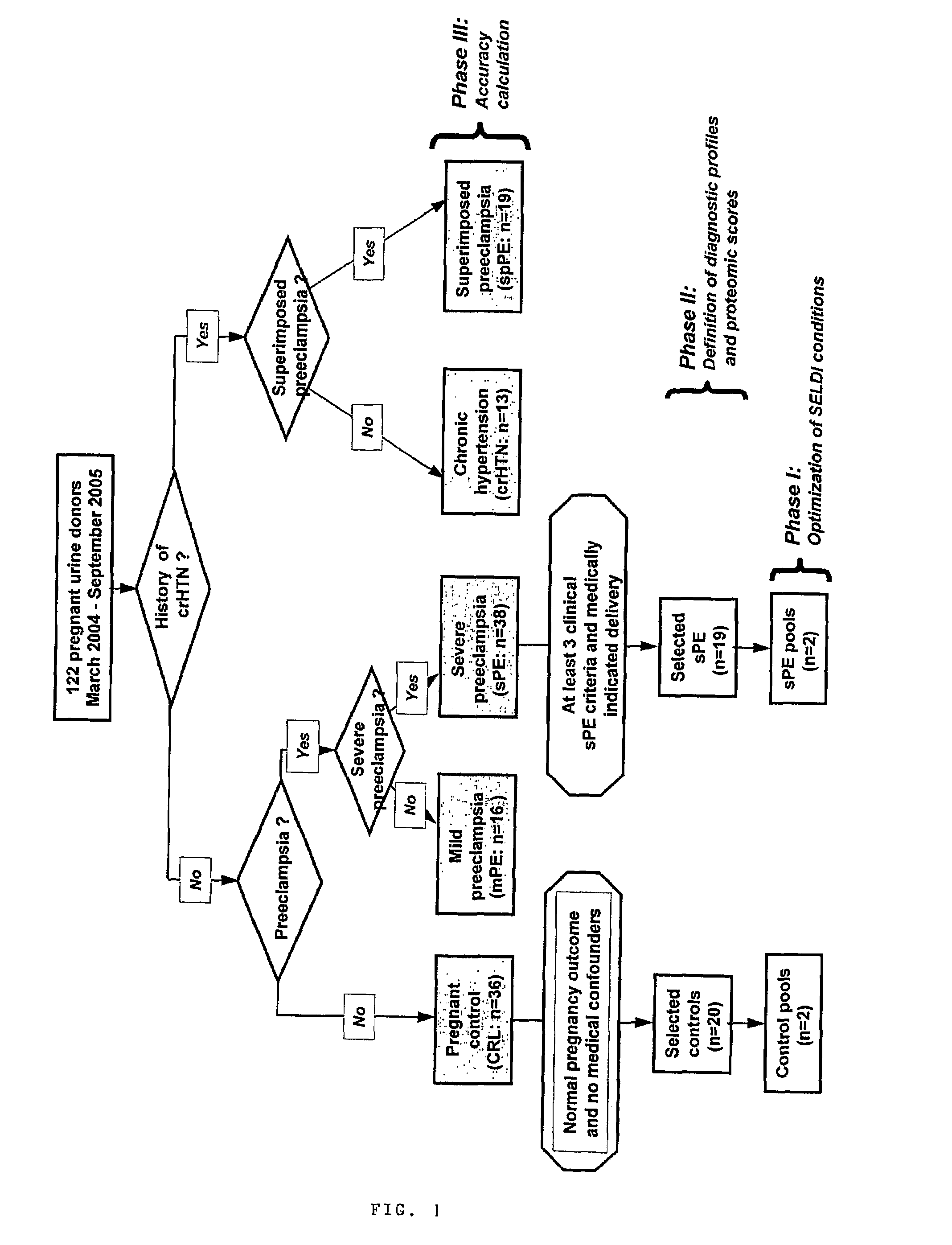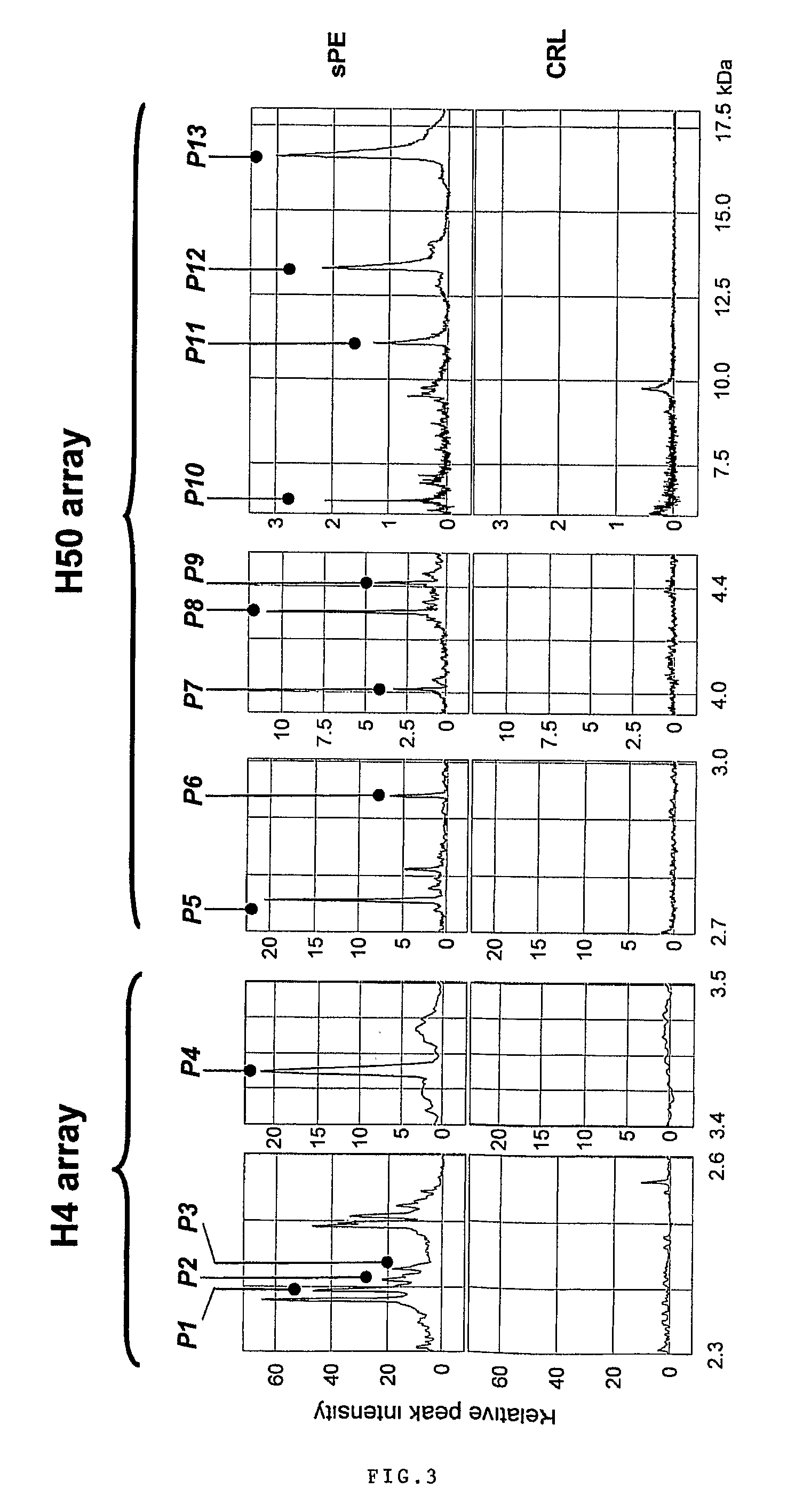Urinary proteomic biomarker patterns in preeclampsia
a proteomic biomarker and preeclampsia technology, applied in the field of proteomic biomarkers to diagnose preeclampsia, can solve the problems of increased neonatal mortality and morbidity, and the diagnosis of sppe is particularly difficul
- Summary
- Abstract
- Description
- Claims
- Application Information
AI Technical Summary
Benefits of technology
Problems solved by technology
Method used
Image
Examples
example 1
Methods
Patients and Clinical Definitions:
[0096]Urine samples from 122 pregnant women admitted at Yale New Haven Hospital between March 2004 and September 2005 have been studied. Samples were collected under protocols approved by the Human Investigation Committee of Yale University. All participants provided informed consent prior to enrollment and all women solicited for enrollment agreed to participate. Subjects were recruited from women evaluated or admitted to or the Labor and Birth unit and the antepartum High and Low Risk units. Gestational age was established based on menstrual date and / or ultrasonographic examination prior to 20-weeks gestation. Women were clustered into clinical categories based on the clinical judgment of the practitioner at enrollment. In the clinical setting this judgment was based on the widely accepted clinical criteria for diagnosis and categorization of preeclampsia. (ACOG Committee on Practice Bulletins. Obstet Gynecol. 99(1):159-67, 2002.) Severe pr...
example 2
Ability of Proteomic Profiling of Urine to Predict Development of Preeclampsia
[0122]A group of women at either low risk or at high risk of developing preeclampsia were followed longitudinally. Pre-pregnancy conditions for the high-risk group included: chronic hypertension, a history of severe preeclampsia, poorly controlled diabetes, diabetic nephropathy, nephrolitiasis and / or sickle cell disease with history of crisis. Since the initiation of this longitudinal arm of the study in March 2006 a group of 11 women have known outcomes (3 low risk and 8 high risk). 3 of the 11 women developed either preeclampsia or superimposed preeclampsia. FIG. 5 shows the urine proteomic scores acquired during pregnancy and before the clinically manifest disease. For the group that did not develop preeclampsia (white bars) and for the ones who did (black bars). The dashed line represents the cut-off of 6 in UPSb or 8 in UPSr. It has been established that for a women to be classified as preeclamptic ba...
example 3
Quantification of Serum and Urine Serpina-1 Immunoreactivity in Preeclampsia
Background
[0123]Alpha-1 antitrypsin (A1AT or serpina-1) is an abundant plasma protein being the main blood-borne serine protease inhibitor. Although its primary function is the inhibition of neutrophil elastase [Luft F C. J Mol Med 1999; 77: 359-60] it also has activity against catepsin G, proteinase 3, pancreatic elastase, trypsin, chymotrypsin and collageanses [Lisowska-Myjak B. Clin Chim Acta. 2005; 352:1-13, kallikrein]. The antiproteolytic activity is explained by formation of 1:1 enzyme-A1AT complex. This results in the proteolytic cleavage of the reactive center peptide bond between Met 358 and Ser 359 of the secreted form of A1AT [Carrell R W. alpha 1-Antitrypsin: molecular pathology, leukocytes, and tissue damage. [J Clin Invest. 1986; 78:1427-31]. A1AT is synthesized by the liver, macrophages and neutrophils and also by trophoblast [Bergman D et al. Pediatr Res. 1993; 34: 312-7]. Increases in serum...
PUM
| Property | Measurement | Unit |
|---|---|---|
| molecular mass | aaaaa | aaaaa |
| systolic blood pressure | aaaaa | aaaaa |
| systolic blood pressure | aaaaa | aaaaa |
Abstract
Description
Claims
Application Information
 Login to View More
Login to View More - R&D
- Intellectual Property
- Life Sciences
- Materials
- Tech Scout
- Unparalleled Data Quality
- Higher Quality Content
- 60% Fewer Hallucinations
Browse by: Latest US Patents, China's latest patents, Technical Efficacy Thesaurus, Application Domain, Technology Topic, Popular Technical Reports.
© 2025 PatSnap. All rights reserved.Legal|Privacy policy|Modern Slavery Act Transparency Statement|Sitemap|About US| Contact US: help@patsnap.com



